Lea Wait's Blog, page 73
January 6, 2023
Weekend Update: January 7-8, 2023
 Next week at Maine Crime Writers there will be posts by Joe Souza (Monday), John Clark (Tuesday), Vaughn Hardacker (Thursday), and Maggie Robinson (Friday).
Next week at Maine Crime Writers there will be posts by Joe Souza (Monday), John Clark (Tuesday), Vaughn Hardacker (Thursday), and Maggie Robinson (Friday).
In the news department, here’s what’s happening with some of us who blog regularly at Maine Crime Writers:
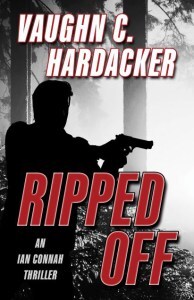
RIPPED OFF
Vaughn C. Hardacker’s seventh thriller,RIPPED OFF, is scheduled for release by Encircle Publications on January 25th. It is available for preorder.
Retired or not, never double-cross a hitman…A former hitman’s retirement bankroll has been stolen. To recover his money, the quest will lead him from Maine to Boston, Boston to the Caribbean Islands, and then to the Amazon Rainforest of Brazil. He will be faced with crooked lawyers, South American drug lords, and the largest and most violent of Brazil’s criminal syndicates.Signed copies can be ordered from vaughn at vhardacker@gmail.com.
An invitation to readers of this blog: Do you have news relating to Maine, Crime, or Writing? We’d love to hear from you. Just comment below to share.
And a reminder: If your library, school, or organization is looking for a speaker, we are often available to talk about the writing process, research, where we get our ideas, and other mysteries of the business, along with the very popular “Making a Mystery” with audience participation, and “Casting Call: How We Staff Our Mysteries.” We also do programs on Zoom. Contact Kate Flora
WAIT FOR IT?
by Jule Selbo
I’m reading John Grisham’s 2021 release The Judge’s List.
 Very soon – as I was reading – I got interested in how – in the first 100 pages, Grisham’s employed the “I can’t tell you now”, “I can’t tell you everything I know”, “I can’t tell you here”, “I can’t let you look at the file that is right here in my hand because I am afraid/untrusting/paranoid” and “If you meet me tomorrow, I’ll tell you more” technique. I have to admit, I got a little frustrated, but I could see, story-wise, what he was using the page space for:
Very soon – as I was reading – I got interested in how – in the first 100 pages, Grisham’s employed the “I can’t tell you now”, “I can’t tell you everything I know”, “I can’t tell you here”, “I can’t let you look at the file that is right here in my hand because I am afraid/untrusting/paranoid” and “If you meet me tomorrow, I’ll tell you more” technique. I have to admit, I got a little frustrated, but I could see, story-wise, what he was using the page space for:
Question: What’s your preference? Does this kind of overt withholding of information work for you or do you prefer to give as much information as you can at each turn – to see how the story can deepen from there?

I’ve just gone back into The Judge’s List to count the days that have passed in the first 100 pages. Three workdays, a weekend, two more workdays – a total of seven days. There are multiple times Lacy tells Jeri, “I can’t help you”, “Don’t call me again”, “This is not what the BJC does”, “My boss says we can do nothing”, “You have no proof, so there is no case.”. Lacy’s continual “no” to pursuing the case is juxtaposed with her picking up the phone and/or agreeing to meet Jeri over and over again. This push and pull of Lacy’s intent makes the reader see her deep need to get excitement into her life – for the rush she gets from entering a danger zone when on the hunt for a bad judge who really needs to be put away.
Alert: SPOILER (Stop reading if you haven’t read the book and plan to read it and you hate spoilers. My husband doesn’t mind them because he’s trained his mind to only retain information on cars, boats and new cocktail recipes. (At least that’s what it seems like to me.))
So, at page 100 or so, the story kicks in. There’s a twist. There’s a new murder. Lacy kicks off her doldrums about life, work, love. She accepts a promotion. Now she can make larger decisions at the BJC office – i.e. what cases to pursue, where to put the manpower. Her curiosity, her hunger for glory, the thrill she gets living on the edge is now able to move forward.
Question: Is the 100 page mark the “typical time” for a shift, for the raising of stakes, of knowing that set up now must be over and more aggressive crime-solving action must become paramount?
I like procedurals, reading about and learning about how the professionals solve crimes. I also like amateur sleuths because most, in their pursuit of justice, are dogged and obsessed and make plenty of mistakes. I like the hybrid nature of Lacy – part amateur and part pro. She has skills, she knows the law, she knows her given role in the pursuit of crime solving – but she’s untrained in things like surveillance, use of guns, etc. This hybrid works for me.
Some amateur sleuths boggle my mind. Late one night, when wanting to veg, I happened on a crime show, In the Dark (2019-2022, a CW show).

The amateur sleuth (Murphy) is in her twenties, she’s blind, she’s selfish, she’s a sexaholic and alcoholic, she uses people, and she expects huge passes on her arrogant behavior because of her disability. She works at a Guide Dog School, screws up and/or bags on her job constantly (to have sex or follow clues on a crime she’s interested in). Viewers are meant to care for Murphy because she’s flippant, self-deprecating, pretty and she’s got a great guide dog and she does bond with a few people.

In the first season, one of few friends she has gets murdered; she’s devastated and becomes obsessive about finding the killer. She outsmarts cops and entrenched criminals, stumbles (literally because of her disability) into great danger. As a viewer, I sometimes laugh out loud as her (unbelievable) survival skills. But – I admit, I’m still watching (just finished season one). What’s keeping me watching? I guess wanting to see how the writers complicate the stories, how they deal with Murphy’s disability, and hoping she might actually decide to learn some actual procedural skills. (I won’t hold my breath – this is a CW show and aimed at viewers who like aspiration, are fine with stereotypes, appreciate nice make-up (Murphy, the blind protagonist wears perfect eyeliner, mascara and lipstick at all times). CW viewers tune in for more broad stroked-stories, don’t worry too much about logic – the programming is usually not out to explore a more ‘reality’ based story palate (IMO).)
But back to WAIT FOR IT. In the Dark has 13 episodes per season. A crime is committed in episode one and the solving of it takes 12 more episodes. The amount of not giving known information, of withholding information that, if shared, could solve the crime much sooner is huge.

Sometimes this is accomplished by using an interruption of an opportunity for sex (which, of course, must take precedence over crime-solving) or a bar fight or malevolent of benevolent stonewalling, getting in the middle of a drug deal or a birthday party at the Guide Dog School. I am having a lot of fun watching the show and yelling at the screen.
Question: Are you a tortoise when it comes to information sharing? 
 Or are you a hare?
Or are you a hare?
Every story’s going to have its own form and pace. But when is “slow” too slow? Is parsing out information a style? Not even sure what I’m exploring here, but Grisham’s book and this improbable television show got me thinking about these questions.

January 4, 2023
My 2022 Stack
I didn’t need socks this year. The bottom drawer of my dresser is jammed so full I struggle to close it sometimes, so Smartwools weren’t on my list.
Similarly, I’ve got plenty of scarves, hats, gloves.
I didn’t need any kitchen gadgets, but I got a few new ones. You’ll never hear me complain about that.
But many of the people in my life bought me books for Christmas, a treasure trove for which I am grateful. Here’s the 2022 stack.
Anyone who’s seen the bookshelves in our house knows the multiple meanings of this picture—(a) my friends and family are generous when they feed my hunger for books and (b) it’s time to box up some of those I’ve already read to make room for the new arrivals.
At the turn of each year, we cull books we don’t feel the need to keep into sturdy boxes and deliver them to one of the several libraries in our lives, then fill the gaps on the shelves with fresh literary loot. This year brought some terrific fiction and non-fiction, and I cannot wait to dive in.
Fintan O’Toole writes for the Irish Times, primarily. He’s also been a drama critic for the New York Daily News and written for The Guardian and The New York Review of Books, among other publications. 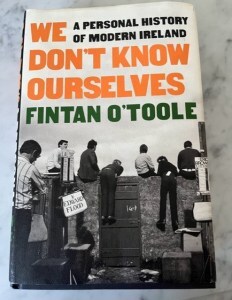 I appreciate his sharp eye and incisive writing style, and was so pleased to find his newest book, We Don’t Know Ourselves – A Personal History of Modern Ireland under my tree.
I appreciate his sharp eye and incisive writing style, and was so pleased to find his newest book, We Don’t Know Ourselves – A Personal History of Modern Ireland under my tree.
On the subject of journalism, I was thrilled to unwrap Margaret Sullivan’s memoir, Newsroom Confidential, Lessons (and Worries) from an Ink-Stained Life. The former media critic for The Washington Post, Sullivan also served for three-plus years as public editor of the New York Times.
 Last month I heard her being interviewed on the CBC, and it was evident her lens on the media was shaped by her many years at The Buffalo News—a regional rather than a national newspaper—one reason I’m especially eager to read this book.
Last month I heard her being interviewed on the CBC, and it was evident her lens on the media was shaped by her many years at The Buffalo News—a regional rather than a national newspaper—one reason I’m especially eager to read this book.
Staying with the newspaper theme, last year I enjoyed Val McDermid’s 1979, featuring rookie newspaper reporter Allie Burns fighting for scoops at a scrappy daily in Glasgow around the same time I was in journalism school. 1989 is the sequel, with Allie ten years older and wiser, and the world a different place for a multitude of reasons. I’m hoping for a snowed in weekend to devour this one.
I’m also keen to settle in with the other books in my stack—Eli Cranor’s Don’t Know Tough is drawing raves, I’ve been tardy getting to Rosalie Knecht’s Vera Kelly books, and Kathryn Shultz’s memoir Lost & Found promises to be a powerful, moving read.
Sharp eyes also will spot a cookbook, The World in a Skillet, by the fabulous cooks at Milk Street Kitchen. This will complement the beautiful cast iron skillet I received as a gift last year, which has become my go-to pan.
Finally, an important hole in my bookshelves has been filed by two books by one of my favorite children’s book authors, the late Robert McCloskey. I don’t know what happened to my earlier versions of Burt Dow, Deep Water Man and One Morning in Maine, but I’m glad to have received replacement copies this Christmas.  These are great to have on hand when young friends visit. But sometimes a woman just needs to settle in with a book ostensibly written for kids, and McCloskey’s illustrated tales —like those of E.B. White, who also set his children’s stories in Hancock County—are deeply pleasurable reads no matter one’s age.
These are great to have on hand when young friends visit. But sometimes a woman just needs to settle in with a book ostensibly written for kids, and McCloskey’s illustrated tales —like those of E.B. White, who also set his children’s stories in Hancock County—are deeply pleasurable reads no matter one’s age.
Happy New year to all of our readers here at MCW. Please let us know in the comments what books you received as gifts and/or are looking forward to reading in the new year.
Brenda Buchanan brings years of experience as a journalist and a lawyer to her crime fiction. She has published three books featuring Joe Gale, a newspaper reporter who covers the crime and courts beat. She is now hard at work on new projects. FMI, go to http://brendabuchananwrites.com
January 3, 2023
Better Taken with a Grain of Salt?
A tweaked and recycled post from a few years ago, advice to be considered as those of us who do so are making New Year’s Resolutions to try writing, or to write more, in the new year.
Kate Flora: As we enter another writing year, and may be making New Year’s  resolutions which include finally writing that book you’ve always dreamed of writing, I am here to help you along on your journey, by sharing pieces of advice I’ve gotten over the years which have proved singularly unhelpful. I share them as a warning against the world of writing advice with this caveat: Don’t take them at face value, or assume they are true for you, until you’ve tested them against your own experience, your own instincts, and seen whether they advance your writing or impede it. Some of them may work for you.
resolutions which include finally writing that book you’ve always dreamed of writing, I am here to help you along on your journey, by sharing pieces of advice I’ve gotten over the years which have proved singularly unhelpful. I share them as a warning against the world of writing advice with this caveat: Don’t take them at face value, or assume they are true for you, until you’ve tested them against your own experience, your own instincts, and seen whether they advance your writing or impede it. Some of them may work for you.
If something you’ve written in your work-in-progress makes you cry when you
 reread it, excise it, cut it, leave it out. This is something I totally disagree with. I have some bits in books I’ve written over the years that still make me cry when I reread them. It just may be that there’s nothing wrong with powerful emotion in our books. If you have a section you’re worried about because someone has given you the advice above, try it out on a few beta readers and see if they think it should be cut. Always be ready to listen to advice but also be open to listening to your instincts. In the end, it is YOUR work.If you don’t know how to write, it’s necessary to take several writing classes and read lots of writing books. I think here the answer is: not so fast. I love teaching, and yes, it helps to learn some craft and spend time in classes where you can get feedback from instructors and other students. But there is a downside–the risk that you will fill your head so full of advice about what the rules are (rules that often vary from one instructor to another) that you lose any ability to be spontaneous. There’s also the risk that you won’t be discovering yourself as writer. You won’t be developing a practice to get your writing done if you’re always filling your time with classes. You may become so wedded to prompts and assignments that you aren’t listening to your own imagination, exploring your own individual creativity, or learning what parts of the writing craft actually enchant you.Don’t write a word until you’ve written an outline. Again, not necessarily. If you’re a
reread it, excise it, cut it, leave it out. This is something I totally disagree with. I have some bits in books I’ve written over the years that still make me cry when I reread them. It just may be that there’s nothing wrong with powerful emotion in our books. If you have a section you’re worried about because someone has given you the advice above, try it out on a few beta readers and see if they think it should be cut. Always be ready to listen to advice but also be open to listening to your instincts. In the end, it is YOUR work.If you don’t know how to write, it’s necessary to take several writing classes and read lots of writing books. I think here the answer is: not so fast. I love teaching, and yes, it helps to learn some craft and spend time in classes where you can get feedback from instructors and other students. But there is a downside–the risk that you will fill your head so full of advice about what the rules are (rules that often vary from one instructor to another) that you lose any ability to be spontaneous. There’s also the risk that you won’t be discovering yourself as writer. You won’t be developing a practice to get your writing done if you’re always filling your time with classes. You may become so wedded to prompts and assignments that you aren’t listening to your own imagination, exploring your own individual creativity, or learning what parts of the writing craft actually enchant you.Don’t write a word until you’ve written an outline. Again, not necessarily. If you’re a  person who can’t tackle a project without an outline or some signposts to guide you along the way, then yes, do an outline. It doesn’t have to be the kind we learned in 6th grade. But many writers aren’t plotters but pantsers, and love the excitement of discovery that comes with waiting to find out what happens next. See advice in 2, above. You have to actually write for a while to discover what kind of a writer you are, and that means hours at the keyboard, by yourself, finding yourself as a writer, not waiting to be told who you are by someone else.You should pick a writer whose style you admire, and learn to imitate that. See my comments above. Learning to distinguish the elements of particular styles can give you tools in your writer’s tool box to choose from, but slavish imitation, sometimes unaware imitation, will come between you and the writer you’re meant to be. There are great prompts in John Gardner’s The Art of Fiction asking you to write several styles, and this is a fun exercise to do. In the end, though, you want to be you the writer, not an imitator.Don’t worry if you don’t have an idea today, write only when the spirit moves
person who can’t tackle a project without an outline or some signposts to guide you along the way, then yes, do an outline. It doesn’t have to be the kind we learned in 6th grade. But many writers aren’t plotters but pantsers, and love the excitement of discovery that comes with waiting to find out what happens next. See advice in 2, above. You have to actually write for a while to discover what kind of a writer you are, and that means hours at the keyboard, by yourself, finding yourself as a writer, not waiting to be told who you are by someone else.You should pick a writer whose style you admire, and learn to imitate that. See my comments above. Learning to distinguish the elements of particular styles can give you tools in your writer’s tool box to choose from, but slavish imitation, sometimes unaware imitation, will come between you and the writer you’re meant to be. There are great prompts in John Gardner’s The Art of Fiction asking you to write several styles, and this is a fun exercise to do. In the end, though, you want to be you the writer, not an imitator.Don’t worry if you don’t have an idea today, write only when the spirit moves you, the muse appears, or you’re inspired by a great idea. Nope. Despite the fact that we’re surrounded by those people who say, “I always wanted to write, but I tried it once and it was hard,” the truth is that writing is hard, but writers go to their desks and write on the days when their heads ache, when they’d rather rub themselves with sandpaper, when it seems like everything they write is gravel. Writing is a job–often a great job–but still a job, and so we go to work. This means you will be there, at your desk, fingers curled over the keys, at the magic moment when the fluttery little muse deigns to visit and whisper words in your ear. When you suddenly get into a flow so exhilarating you can hardly catch your breath. But we earn those moments by spending time with gravel or the merely adequate.Read all the bestsellers in the genre you plan to write in, and then write a book like that. It’s sure to sell. Alas, although it’s true that agents and editors always think they want a book just like the last bestseller, only different, by the time you’ve spent a year writing that book, there will be a new new thing and your book will be yesterday’s news. You’re much better off writing the story that enchants you, that matters to you, that you can immerse yourself in. There’s no guarantee you’ll sell that one, either, but at least the journey will have been a good one.
you, the muse appears, or you’re inspired by a great idea. Nope. Despite the fact that we’re surrounded by those people who say, “I always wanted to write, but I tried it once and it was hard,” the truth is that writing is hard, but writers go to their desks and write on the days when their heads ache, when they’d rather rub themselves with sandpaper, when it seems like everything they write is gravel. Writing is a job–often a great job–but still a job, and so we go to work. This means you will be there, at your desk, fingers curled over the keys, at the magic moment when the fluttery little muse deigns to visit and whisper words in your ear. When you suddenly get into a flow so exhilarating you can hardly catch your breath. But we earn those moments by spending time with gravel or the merely adequate.Read all the bestsellers in the genre you plan to write in, and then write a book like that. It’s sure to sell. Alas, although it’s true that agents and editors always think they want a book just like the last bestseller, only different, by the time you’ve spent a year writing that book, there will be a new new thing and your book will be yesterday’s news. You’re much better off writing the story that enchants you, that matters to you, that you can immerse yourself in. There’s no guarantee you’ll sell that one, either, but at least the journey will have been a good one.I could go one and on, but that’s enough for today. Don’t be discouraged. Writing is hard, sometimes brutally hard. It’s also magical, and so addictive that even when the books don’t sell, or don’t sell well, we don’t give up. And my one piece of advice, learned the hard way through ten years in the unpublished writer’s corner: Be stubborn. Be your own best cheerleader. While it’s true that rarely will someone knock on your door and demand the chance to publish your novel, and also true that getting published can be a brutal process filled with rejection, only you get to decide that you’re a writer.
January 1, 2023
The Dress With Stars
Kaitlyn Dunnett/Kathy Lynn Emerson here, today broaching a serious subject to start the new year. As many of my readers (especially those of the “Deadly Edits” series) already know, I grew up in Sullivan County, New York in the foothills of the Catskill Mountains. By the time I was born in 1947, that area was popularly known as the Borscht Belt and famous as the training ground for countless successful stand-up comedians. It was also a destination for thousands of Jewish vacationers every summer. Why? Because Jews were discriminated against in hotels in many other places. Resorts like Grossinger’s, which was located in my home town, were a haven for Jewish visitors as well as mainstays of the local economy.

Grossinger’s Hotel (known locally as “the G”)
My mother’s family ran a farm/boardinghouse in a nearby village. They never discriminated when it came to accepting guests. Summer visitors of all faiths, and indeed, all colors, stayed there. But not everyone in the area was so open-minded. On one memorable occasion in the late 1920s or early 1930s, the KKK burned a cross on the hill behind the family farm.
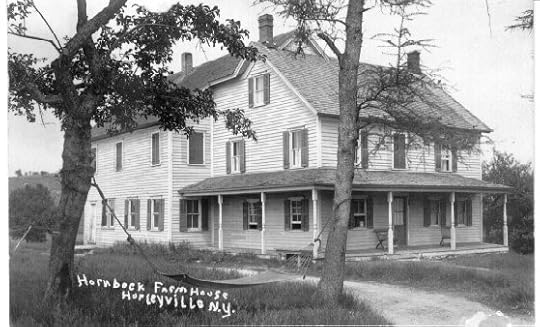
As a young child, I lived in blissful ignorance for the first eight or so years of my life. Frankly, I didn’t pay any attention to where my friends worshipped. Looking back, I know that the neighborhood kids included Protestants, Catholics, and Jews. They also included twins who came to the U.S. from Germany with their mother. She didn’t speak any English, which couldn’t have made her too popular, since it was just a few years after the end of World War II.

1954 7th birthday party: Iris Summerson, Wendy MacNair, me, Patty Vandruff, Hansy Hartman, Carmen Hartman, Marty Guttenberg, ??, Steve Guttenberg
At that age, I’m not sure I even realized there had been a war. My father fought in it, but he never talked about it. Nobody talked about the Holocaust. And I had no idea what anti-Semitism meant.
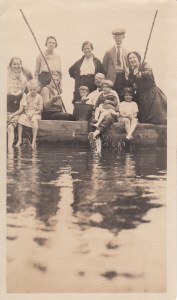
fishing in the farm pond: Mrs. Shall, Mrs. Wolf, ?, ?, Mrs. Ash; ?, my mom, ?, Ash boy, Mr. Wolf, Ruthie Shall, Muriel Ash
And that brings me to the dress with stars.
I’m not sure how old I was, but I’m guessing I was in second or third grade. I was in school, sitting at my desk, and I was making a drawing. I drew a picture of a woman wearing a dress and for some reason I decided to decorate that dress with stars. Since it is easier to draw six-pointed stars (two triangles) than five-pointed stars, I was busily drawing six-pointed stars on the dress when a boy in my class stopped beside me, pointed at the drawing, and said, “You’re anti-Semitic.”
I had no idea what he was talking about.
I don’t remember who explained to me what anti-Semitic meant. Or when, exactly, I learned why those stars upset him so badly. I don’t even know if he was one of the kids in my class whose parents had survived the concentration camps, but he may have been. What troubles me most, looking back on it, is the feeling that the whole subject was glossed over for most of the time I was growing up. Even growing up where I did. Even with so many Jewish friends.
I do not remember learning about the Holocaust in history class. If it was taught at all, it didn’t make much of an impression. That’s not to say I didn’t know about the horrors of Nazi persecution of Jews and other minorities, but what I knew came more from reading The Diary of Anne Frank (which was also performed as a senior class play when I was a freshman in high school) and from both the book and the film of Leon Uris’s Exodus.
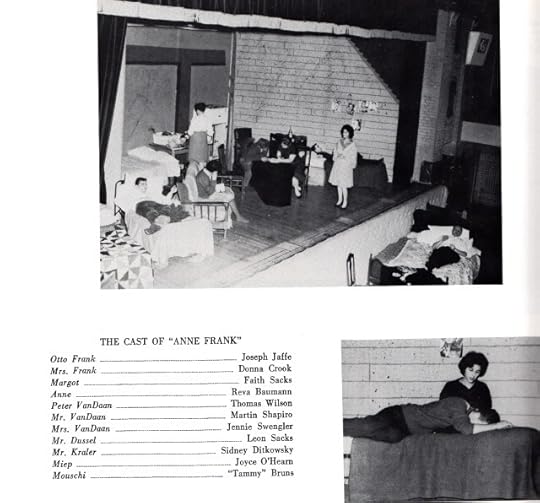
March 1962 production
As a sign of the times (?) all the yearbook captions were meant to be funny
I may not have been guilty of anti-Semitism some sixty-five-plus years ago, but I was guilty of ignorance and insensitivity. I didn’t know any better then. I do now. The sad thing about my experience, and the point of this story, is that here we are in 2023 and far too many kids still don’t know any better. Neither do some adults. And far too many people don’t care enough to find out why their insensitivity and ignorance matter.
Here’s a litmus test from today’s headlines: what reaction did you have to hearing that George Santos lied about his grandparents being Holocaust survivors and made a bad joke about being Jew-ish?
Think about it.
******
Kathy Lynn Emerson/Kaitlyn Dunnett has had sixty-four books traditionally published and has self published others, including several children’s books. She won the Agatha Award and was an Anthony and Macavity finalist for best mystery nonfiction of 2008 for How to Write Killer Historical Mysteries and was an Agatha Award finalist in 2015 in the best mystery short story category. She was the Malice Domestic Guest of Honor in 2014. Her most recent publications are The Valentine Veilleux Mysteries (a collection of three short stories and a novella, written as Kaitlyn) and I Kill People for a Living: A Collection of Essays by a Writer of Cozy Mysteries (written as Kathy). She maintains websites at www.KaitlynDunnett.com and www.KathyLynnEmerson.com.
December 30, 2022
Weekend Update: December 31, 2022-January 1, 2023
 Next week at Maine Crime Writers there will be posts by Kaitlyn Dunnett/Kathy Lynn Emerson (Monday), Kate Flora (Tuesday), Brenda Buchanan (Thursday), and Jule Selbo (Friday).
Next week at Maine Crime Writers there will be posts by Kaitlyn Dunnett/Kathy Lynn Emerson (Monday), Kate Flora (Tuesday), Brenda Buchanan (Thursday), and Jule Selbo (Friday).
In the news department, here’s what’s happening with some of us who blog regularly at Maine Crime Writers:
An invitation to readers of this blog: Do you have news relating to Maine, Crime, or Writing? We’d love to hear from you. Just comment below to share.
And a reminder: If your library, school, or organization is looking for a speaker, we are often available to talk about the writing process, research, where we get our ideas, and other mysteries of the business, along with the very popular “Making a Mystery” with audience participation, and “Casting Call: How We Staff Our Mysteries.” We also do programs on Zoom. Contact Kate Flora
Maine Crime Writers Look Ahead to 2023
In today’s group post, we’re sharing some what lies ahead for us in the next year. New books or stories being published, new ventures undertaken. Whatever the journey will be in the year ahead.
Kate Flora: I am absurdly excited that a domestic suspense novel I’ve worked on, loved, and revised for at least twelve years, Teach Her a Lesson, will be published in May by Encircle Publications. 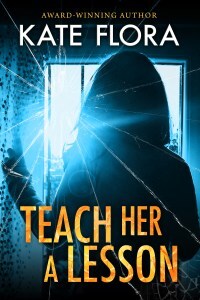
I’m also looking forward to a new published short story, Fideau Saves the Day, in an as yet untitled anthology of short stories featuring characters in contributor’s mystery series. It was fun to write about the clever dog Joe Burgess acquired from a bad guy who was arrested.
What do your, our readers, think about a our doing a MCW holiday story anthology?
Maggie Robinson: With any luck, The Book That Will Not Finish Itself will somehow get finished, a holiday novella related to it will miraculously appear thereafter, and the seeds of Something New, Contemporary and Quirky will germinate. 2022 was a somewhat lackadaisical writing year for me, and I have all the good intentions to change that. Of course, you know where that road leads. 
John Clark hopes to be ambitious in 2023. With ten or so unpublished books and a potential anthology of mystery/horror stories demanding to be published, Something Gotta Give.
Kaitlyn Dunnett/Kathy Lynn Emerson: I’m still plugging along on the total rewrite of my 1991 historical novel, Winter Tapestry. Originally written as a mystery, it didn’t sell in that genre but I was offered the chance to have it published as historical romance if I’d just “add 10,000 words” and beef up the romantic elements. The novel ended up being described as “a romantic adventure in Tudor England” and never quite fit into either the mystery or the romance genre. That version had multiple point of view characters. The current effort has just one and I think it’s going to be much better for it. I hope to finish a complete draft by the end of 2022 and then take as much time as I need in 2023 to revise and polish. Still up in the air is whether I will self-publish or try to get my agent interested in hawking it as a “new” book. I haven’t changed the characters or who gets murdered or why, but just about everything else is completely different. Wish me luck.
Jule Selbo: I will be storming ahead on 8 DAYS, A Dee Rommel Mystery and have put as a deadline for myself for a solid draft – the end of February, 2023. I am at a juncture in it now where I am tearing my hair out – but I hope this misery will pass and I can get it down. That means I could get it to my publisher end of March – and since it is a series, they have pushed the edit/cover/etc stuff through pretty quickly. If it could come out end of June????(cross fingers) I’d be two months ahead of how 9 DAYS, A Dee Rommel Mystery took. I finish my last semester of university professor-ing May 2023 and though I’ll miss reading my students’ screenplays and adding guidance/thoughts/opinions to them – it will be marvelous to have that time back into “my creative life”. CRIME BAKE and CRIME WAVE and probably KILLER NASHVILLE are the conferences ahead.
Matt Cost: My historical PI mystery set in 1923 Brooklyn, Velma Gone Awry, will be published on April 12th. Hungarian detective, 8 Ballo, is hired to find a missing young flapper as the tale weaves through legendary celebrities, gangsters, and gets complicated very quickly. Mainely Wicked, the fifth book in my Mainely Mystery series, will be published in August, in which Langdon is hired to find a missing man and becomes involved with witches, Wiccans, and a Wendigo. Pirate Trap, the fifth book in my Clay Wolfe Trap series, will publish in December, in which Clay and Baylee are hired to find a centuries old pirate treasure off the coast of Port Essex.
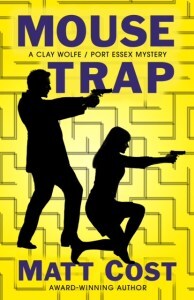
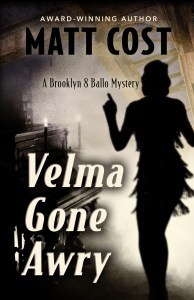
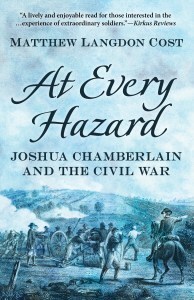
In audio books, Wolfe Trap was just released, and will be followed over the first few months of the year by Mind Trap, Mouse Trap, and Cosmic Trap. Mainely Fear will come to listeners ears at the end of January, hopefully with the rest of the series to follow throughout the year. Velma Gone Awry will debut in audio in the middle of January, three months before the paperback release. At Every Hazard will be available in early February. I hope to follow Jule around to Crime Wave, Killer Nashville, and Crime Bake. And of course, I plan to WRITE ON.
Maureen Milliken: I truly honestly plan on finishing the book I’ve been working on for four years, working title “The Most Dangerous Month.” It is not part of my three-book Bernadette “Bernie” O’Dea series, but once I get MDM done and am flogging it to agents, I plan to write the fourth Bernie O’Dea. I won’t go on and on because after four years everyone, including me, is sick of hearing about it.

Open mouth, insert river and magical days.
Sandra Neily: I can relate to Maggie’s “Book That Will Not Finish Itself.” I do plan to get as close as I can to a finished draft of the 3rd Mystery in Maine, “Deadly Assault.” During the writing, four possible murderers are auditioning for the part of The One That Did It. I heard about this strategy from an A List author at Crime Bake and I did that in Deadly Turn. And I’d like to serialize a sort of memoir that’s part river-guiding anecdotes (folks have begged me to go public with these for years) and part dam fight that hung over the fate of the free-flowing river, even as thousands of us fished, paddled or just loved it … daily. 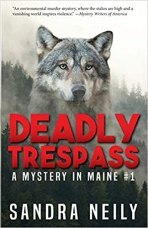 Oh, and if the stock market ever bounces back, I plan to bring out an audio book of Deadly Trespass.
Oh, and if the stock market ever bounces back, I plan to bring out an audio book of Deadly Trespass.
December 29, 2022
Christmas Mysteries
Charlene D’Avanzo: Many eminent crime writers have penned Christmas-themed stories, so, in the spirit of the season, here are a few:
Hercule Poirot’s Christmas by Agatha Christie: On Christmas Eve the Lee Family is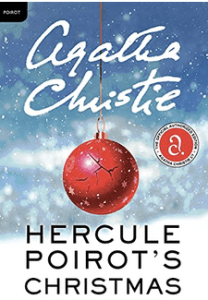 shocked by a loud crash followed by a wailing scream. They rush upstairs to find overbearing Simeon Lee dead in a pool of blood, his throat slashed. Poirot, who is in the neighborhood visiting a friend, offers to help. The problem is that many in the household have motive, but it seems nobody had opportunity.
shocked by a loud crash followed by a wailing scream. They rush upstairs to find overbearing Simeon Lee dead in a pool of blood, his throat slashed. Poirot, who is in the neighborhood visiting a friend, offers to help. The problem is that many in the household have motive, but it seems nobody had opportunity.
“You yearned for a ‘good violent murder with lots of blood’ So this is your special story–written for you–Agatha Christie, from the dedication
The Mistletoe Murder and Other Stories: The Mistletoe Murder collects four of veteran crime writer P. D. James’ Christmas murder mysteries penned for magazines that wanted a good, festive murder. Two of the stories feature her famous detective Dalgliesh, making it an ideal read for newcomers and fans alike.
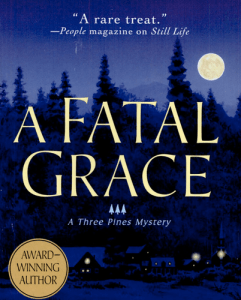 Fatal Grace by Louise Penny “Had CC de Poitiers known she was going to be murdered she might have bought her husband, Richard, a Christmas gift.” With this opening line, Louise Penny, author of the fabulous Chief Inspector Gamache mysteries, informs us that even though we are in the magical (and perhaps even mystical) Canadian town of Three Pines, there is still a gritty reality to be faced, even at Christmas time.
Fatal Grace by Louise Penny “Had CC de Poitiers known she was going to be murdered she might have bought her husband, Richard, a Christmas gift.” With this opening line, Louise Penny, author of the fabulous Chief Inspector Gamache mysteries, informs us that even though we are in the magical (and perhaps even mystical) Canadian town of Three Pines, there is still a gritty reality to be faced, even at Christmas time.
Christmas Carol Murder by Leslie Meir is a terrific holiday cozy set in tiny scenic Tinker’s Cove, Maine. Main character Lucy Stone, a local reporter, stars in the town’s production of A Christmas Carol while the town suffers in a severe recession, especially hard at holiday time. But Jake Marlowe, who owns the Downeast Mortgage company, profits from the town’s struggles. When he turns up dead, there’s no shortage of potential killers. Lucy is tasked with getting to the bottom of this murder.
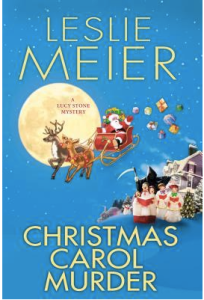
Enjoy!
December 27, 2022
Audio Books & Movies by Matt Cost
I have recently become engaged with the process of turning my novels into audio books. This has been a fascinating journey and has created a few questions in my mind.
I believe writers and readers have long thought it was almost impossible to make a good adaptation from book to movie. This is not an easy process as I became aware when I went to write a screenplay on my novel Wolfe Trap. You must strip away just about everything and then allow the director to recreate it in their vision.
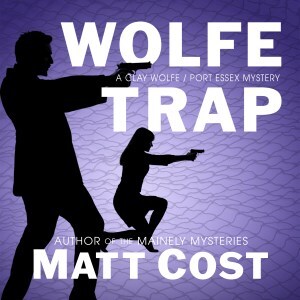
Thoughts inside the heads of characters disappear. Description of people and places are peeled back to expose the underlying structure but not the flesh and bones of the people nor the richness of the place. The story created by the author is denuded and left to the mercy of the elements in a Maine winter.
I can think of several movies that were as enjoyable, maybe even as the book, but certainly not better. The Shining with Jack Nicholson was pretty darn good, but did it exceed the writing of Stephen King? In mystery books to film you’d have to include Murder on the Orient Express (1974), The Big Sleep (1946), and The Maltese Falcon (1941).
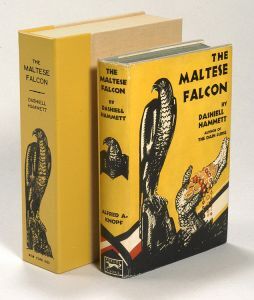
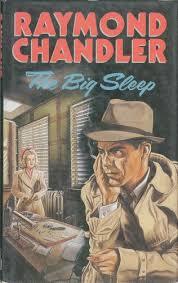
Perhaps the best book to flick adaptation was The Godfather. Francis Ford Coppola worked closely with Mario Puzo to create an honest replication of that towering and intense novel. I’d be glad to hear feedback from others on what books to movie adaptations they think were wildly successful.
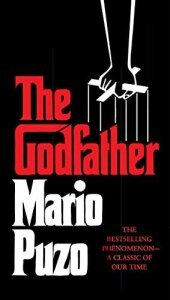

I recently heard an author saying they didn’t care if the movie made from their book was any good or not (I can’t remember who it was). Their reasoning made perfect sense. Either way, they got paid for the rights. If the movie was a bomb, everybody would say the book was better. If the movie was a success, everybody would say good book, good movie. Win, win.
This brings us to audio books which is much easier to adapt, as everything from the book goes into the audio. But there are other factors to consider. For my Trap books, I have a narrator who is pretty straight forward. Jason Arnold. I like his approach and his voice is a perfect match for Clay Wolfe.
He has only a slight change of inflection, accent, and dialect from character to character, which works well for Maine. I’ve heard male narrators who try to sound like females and vice versa and it is usually a disaster. In a perfect world, you have a male and female narrator, or an entire cast, but that is not my reality.
Wolfe Trap is now available, Mind Trap will be next month, followed by Mouse Trap, and then Cosmic Trap.
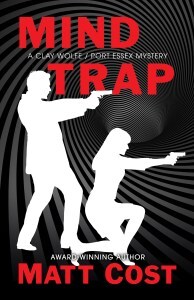

And then there is the dreaded mispronunciation. My narrator for Mainely Power did a marvelous job, and nailed toughies like Topsham, but thought that Bowdoin College was pronounced like it is spelled, with an oin on the end. This has hopefully been corrected to the release next month of book two, Mainely Fear.

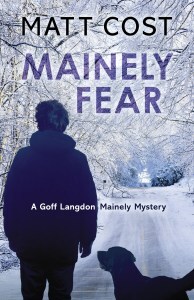
It turns out the narrator for my At Every Hazard historical about Joshua Chamberlain during the Civil War is a pastor. This worked fine for that particular book, but it raised problems for the sequel, Love in a Time of Hate, as that book has graphic violence, sex, and language. It looks like Emmett Collins’ voice will be changing between books….

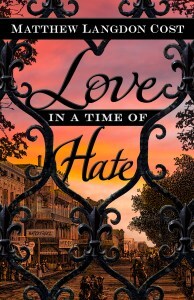
My upcoming book, Velma Gone Awry, coming in April, posed another set of difficulties. It is set in the melting pot of Brooklyn in the 1920’s. The protagonist, 8 Ballo, is a second generation American, so his voice is pretty straightforward. But you also have the Irish cop, the Jewish journalist, the Black entrepreneur, as well as a whole host of Italians, Germans, and eccentric characters.
For Velma Gone Awry, a narrator with a wide range of voices was necessary, and I absolutely love the job that Colin Martin is doing. It should be available in the middle of January. His range is wonderful and brings the book to life. I find myself thinking, oh, that’s how so and so sounds. Are there any audio books that do that for you? I’d love to hear.


I am quite excited to announce the paperback release this past week of the fourth book in the Clay Wolfe Trap series, Cosmic Trap. This time, a government task forces hires Clay and Baylee to investigate unexplained aerial phenomena over the skies of Port Essex.
Write on.
About the Author
Matt Cost was a history major at Trinity College. He owned a mystery bookstore, a video store, and a gym, before serving a ten-year sentence as a junior high school teacher. In 2014 he was released and began writing. And that’s what he does. He writes histories and mysteries.
Cost has published four books in the Mainely Mystery series, with the fifth, Mainely Wicked, due out in August of 2023. He has also published three books in the Clay Wolfe/Port Essex series, with the fourth, Cosmic Trap, due out in December of 2022.
For historical novels, Cost has published At Every Hazard and its sequel, Love in a Time of Hate, as well as I am Cuba. In April of 2023, Cost will combine his love of histories and mysteries into a historical PI mystery set in 1923 Brooklyn, Velma Gone Awry.
Cost now lives in Brunswick, Maine, with his wife, Harper. There are four grown children: Brittany, Pearson, Miranda, and Ryan. A chocolate Lab and a basset hound round out the mix. He now spends his days at the computer, writing.
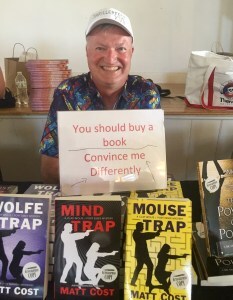
December 25, 2022
Garlic is Better than Ten Mothers
Jim Harrison, the poet, talks frequently in his food writing about discovering garlic for the first time when he moved away from home in the Midwest to New York. I learned about garlic in 1967, in the kitchen of my friend Dominic Giaccobi’s mother, down at the end of Huntington Ave. in Hyde Park.
My mother was a decent cook, though because she worked, our dinners often consisted of the standard: meat, starch, and vegetable, some of it miracle space-age instant food and some of it (vegetables, especially) frozen. Tasting the homemade tomato sauce in Mrs. Giaccobi’s kitchen, sitting at the table after school with her hovering over me saying “Eat, Eat,” introduced me to the wonders of spices and the warmth of the kitchen.
In my hippie headband days, I wore a purple-gray bandana with the legend Garlic is As Good As Ten Mothers. 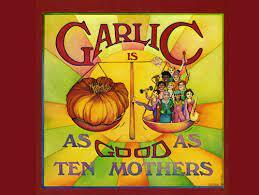 What I didn’t realize until lately was that it referred to a 1980 documentary film about the benefits of garlic called Garlic is as Good as Ten Mothers. Appropriately enough, it was filmed at the Gilroy Garlic Festival in Gilroy, California.
What I didn’t realize until lately was that it referred to a 1980 documentary film about the benefits of garlic called Garlic is as Good as Ten Mothers. Appropriately enough, it was filmed at the Gilroy Garlic Festival in Gilroy, California.
Garlic was my gateway drug to cooking with flavor and spice. As soon as I was away from home and cooking for myself, a woman friend introduced me to rosemary, the sharp piney-resin flavor that enhances roast chicken and lamb. I’ve forgotten her name, but the power of the memory is that I’ve grown rosemary (and garlic) everywhere I’ve lived since then. And oregano, thyme, dill, and parsley.
 A recent dinner with friends, hosted by a couple whose husband is, like me, the family cook, reminded me of Mrs. Giaccobi. Bill, who is also Italian, put together what his family called the Sunday Sauce, slow-cooked meat (sausage, beef, and meatballs), rigatoni pasta, and a dousing of marinara sauce to keep things moist. It was, as many of our gatherings are, a raucous meal, and just what we all needed after this long stretch of not feeling able to meet in groups.
A recent dinner with friends, hosted by a couple whose husband is, like me, the family cook, reminded me of Mrs. Giaccobi. Bill, who is also Italian, put together what his family called the Sunday Sauce, slow-cooked meat (sausage, beef, and meatballs), rigatoni pasta, and a dousing of marinara sauce to keep things moist. It was, as many of our gatherings are, a raucous meal, and just what we all needed after this long stretch of not feeling able to meet in groups.
It’s such a cliché to say that food is love, and yet—we forget. The care Mrs. Giaccobi put into her food was her daily gift, the daylong slow-cooking and tasting from the back of Bill’s stove one of the most potent ways to say that you love people. It’s a way to care for people, to love in the mode of philia, the love for the friends in your circle and the ones who may someday be.
The original phrase, of course, was that garlic is better than ten mothers for keeping the “girls” away. I much prefer the shorter, less specific form. For love, for care of your circle, garlic is as good than ten mothers. Maybe better.
Lea Wait's Blog
- Lea Wait's profile
- 509 followers



